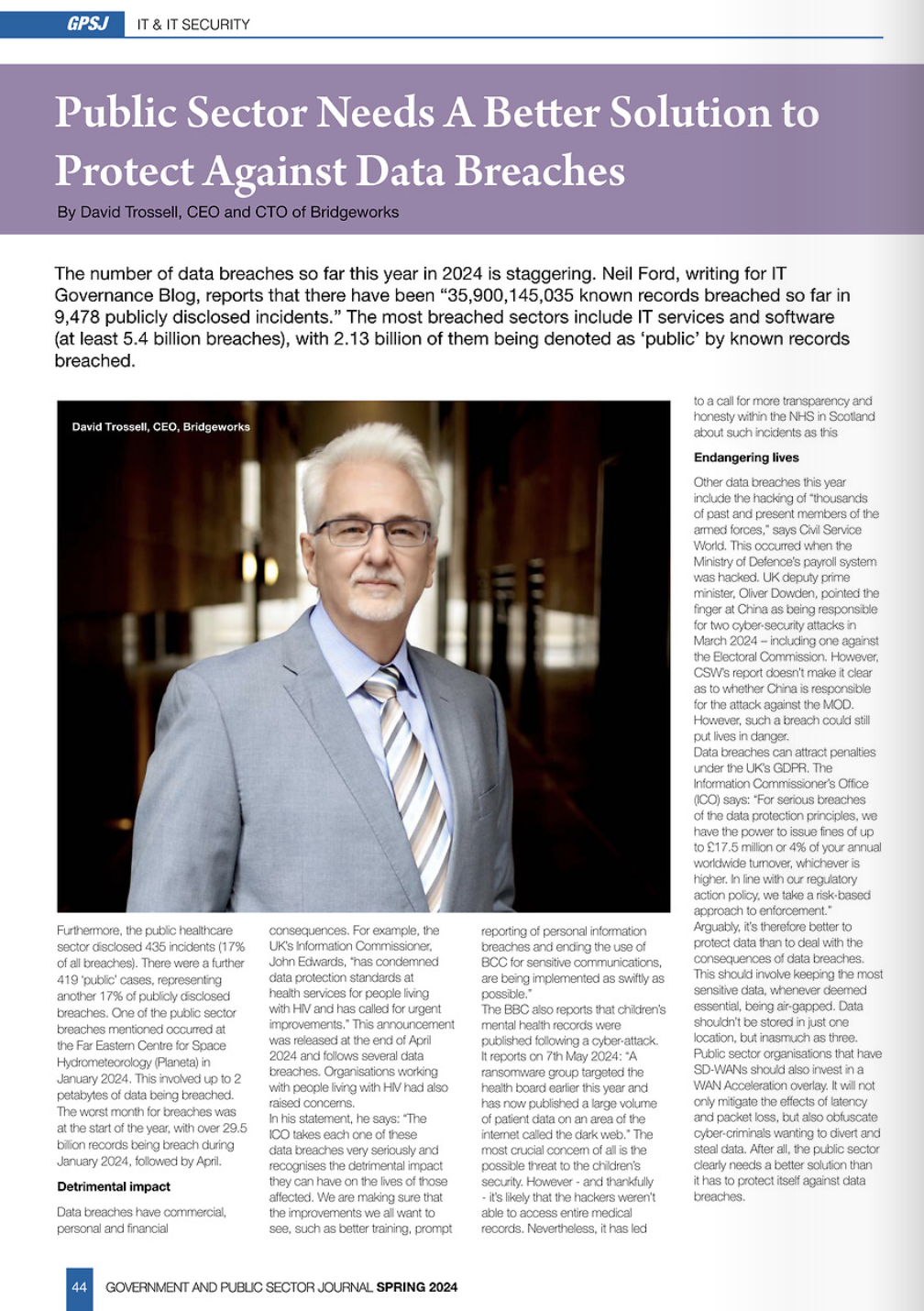Bridgeworks features in this article from GPSJ to discuss the advantages of WAN Acceleration for public sector and government organisations.

April 24, 2023
The public sector continues to promote and undergo digital transformation. The drivers for it range from a need to digitalise operations, to increase innovation and agility or encourage and permit easier collaboration across different Government departments and public sector organisations.
There is also a need for increased data transparency to comply with data protection regulations, to give the public confidence in how their data is used, for what purpose and details of the people using it. There is a claim that digital transformation creates a better organisational culture – a claim which may be disputed by some commentators.
Push for efficiency
With digital transformation comes an increasing amount of data. Spurring it on is the prerequisite for public sector organisations to become more efficient. However, even the UK’s National Audit Office (NAO) finds that His Majesty’s Government has a complex operational landscape.
This is partly due to the existence of legacy IT and ageing data – both of which the NAO considers to be sources of inefficiency, to the extent that they create “a major constraint to improving and modernising government services.” The argument is that poor quality data, legacy systems and networks increase the cost of public sector services.
The NAO adds: “Tackling legacy services is costly and complex, but continuing to use them is risky and commits government to even higher future costs and risks. Failure to modernise legacy systems exposes organisations to possible service disruption, operational failure and cyber-attacks. The increasing costs of maintaining legacy systems and loss of associated specialist skills is unsustainable in the long term.”
The NAO points out that evolution of modern government is considered highly important with an £8bn Spending Review commitment being promised in 2021 to invest in digital, data and technology transformation by 2025. The UK’s Prime Minister, Rishi Sunak, who was Chancellor of the Exchequer at that time, is continuing this commitment as expressed by the current incumbent of 11 Downing Steet, Jeremy Hunt.
AI drive, attainable ambitions
Chancellor of the Exchequer, Jeremy Hunt, recently announced a proposal to help drive artificial intelligence and to boost the UK’s information communications technology industry. Matt Hawkins, CEO and Founder of Cudo – a cloud infrastructure-as-a-Service (IaaS) platform – believes that the dreams of a Silicon Valley in the UK are achievable. That is certainly possible, and that’s despite the collapse of startup funding Silicon Valley Bank. The UK arm of which has been saved by HSBC for £1.
The Government is offering a proposed £1bn fund to encourage science and technology research. He concurs with the Chancellor that AI and Quantum computing are two exciting areas of focus. In fact, leaps forward have already been made over the last few years, and they will continue into 2023.
Legacy networks and systems
However, legacy networks and systems still exist in the public sector. As with commercial organisations, the solution of choice is to call for the modernisation of public sector network infrastructure – quite often with SD-WANs and with Secure access service edge (SASE). This is based on the view that what is old should be replaced by something modern in order to be efficient. Yes, there may be a need in some organisations to buy new kit – from storage to network infrastructure – but that’s not always the case.
There are, nevertheless, proponents of SD-WANs. Adam Stone writes for StateTech: “For many, SD-WAN — a software-defined approach to managing the network — offers a way forward. A virtual architecture that connects applications and users, it offers simplified management, policy templates and detailed performance reporting.”
“SD-WAN can help lower the cost of hardware, improve routing on the network, enable multicloud access and ensure the security and productivity of the hybrid workforce. It supports the rise of automation and can bolster modernisation efforts, such as identity and access management for citizen services.”
The push to modernise
Stone says government and public sector organisations are looking to modernise legacy technology, simplify network management and they are working to enable a hybrid workforce. His view is that Wide Area Networks have helped over the years, but he claims that conventional approaches have their limitations.
For example, Trent Shoultz, Senior Director of Systems Engineering for State and Local Government and Education at Palo Alto Networks in the US, argues that legacy WANs don’t optimise packet flow. They were never designed to do so, as they were not developed to deliver on Service Level Agreements (SLAs) based on application performance – especially with regard to cloud applications.
With legacy WANs, there has often been the need to manage disparate products manually, “adding significant cost and operational overhead”, he says before adding their lack integrated security, a liability for the modern dispersed enterprise.
Limitations of technologies
There is quite often an unspoken need to consider the limitations of technologies before investing in them, and before implementing them. This is no different when it comes to MPLS, WAN Optimisation and SD-WANs. Government and public sector organisations also need to keep an eye out for technologies that could enable ‘Modern Government Enterprises’ to keep their existing infrastructure going. This can be achieved, and would still be an efficient as well as an effective strategy, without adding the costs of investing in new systems, storage and modern network infrastructure.
Network speed also doesn’t have to be sacrificed, as network performance can be increased by mitigating the effects of latency and packet loss. Rather than focusing on bandwidth, public sector organisations could concentrate on increasing their existing bandwidth utilisation as, quite often, the advertised bandwidth of connectivity often falls short.
David Trossell, CEO and CTO of Bridgeworks, comments: “We find that the SD-WAN providers’ support for traditional data flows is now inadequate for today’s high-speed high-volume transfers, and the SD-WAN world is much larger than these providers.” He, therefore, wonders why so many organisations have turned to SD-WANs, and away from MPLS:
“SD-WANs have the ability to bring into play multiple differing transports and this involves combining them under one virtual WAN to address different WAN requirements”. He finds that SD-WANs can bring into play multiple differing transports, which oftens means that they are united under one virtual WAN to address different WAN requirements.
That said, all organisations – including in the private sector – are often happy to put up with limited network performance. The trouble is that “SD-WANs do not solve the problem of latency and its friend packet loss – both of which have a devastating effect on performance,” explains Trossell. MPLS also still suffers from it, albeit to a lesser extent, and so there is a need for a new approach to optimise bandwidth.
SD-WAN-WAN Acceleration
The answer is to deploy an SD-WAN-WAN Acceleration overlay. This offers the benefits of an SD-WANs, while improving network performance by using AI, machine learning and data parallelisation to mitigate the effects of latency bad packet loss, while boosting bandwidth utilisation. This can be done with a solution such as PORTrockIT, which is data agnostic and capable of sending and receiving encrypted data. Now that’s something that WAN Optimisation can’t do.
WAN Acceleration redacts the arguments that something old is essentially inefficient because PORTrockIT can be used to make existing network infrastructure more efficient without having to throw the baby out of the bathwater. This enables organisations – public sector and otherwise – to do more with less, while helping to keep data secure and by reducing the need for a manual human network and infrastructure management. To put it simply, WAN Acceleration saves time, money and resources. It can also significantly boost the performance of SD-WANs.




